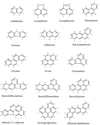Photomutagenicity of 16 polycyclic aromatic hydrocarbons from the US EPA priority pollutant list
- PMID: 14706522
- PMCID: PMC2713671
- DOI: 10.1016/j.mrgentox.2003.10.004
Photomutagenicity of 16 polycyclic aromatic hydrocarbons from the US EPA priority pollutant list
Abstract
The photomutagenicity of 16 polycyclic aromatic hydrocarbons (PAHs), all on the United States Environmental Protection Agency (US EPA) priority pollutant list, was studied. Concomitant exposing the Salmonella typhimurium bacteria strain TA102 to one of the PAHs and light (1.1 J/cm2 UVA+2.1 J/cm2 visible) without the activation enzyme S9, strong photomutagenic response is observed for anthracene, benz[a]anthracene, benzo[ghi]perylene, benzo[a]pyrene, indeno[1,2,3-cd]pyrene, and pyrene. Under the same conditions, acenaphthene, acenaphthylene, benzo[k]fluoranthene, chrysene, and fluorene are weakly photomutagenic. Benzo[b]fluoranthene, fluoranthene, naphthalene, phenanthrene, and dibenz[a,h]anthracene are not photomutagenic. These results indicate that PAHs can be activated by light and become mutagenic in Salmonella TA102 bacteria. At the same time, the mutagenicity for all the 16 PAHs was examined with the standard mutagenicity test with 10% S9 as the activation system. Benzo[b]fluoranthene, benzo[k]fluoranthene, chrysene, acenaphthylene, and fluorene are weakly mutagenic, while the rest of the PAHs are not. In general, the photomutagenicity of PAHs in TA102 does not correlate with their S9-activated mutagenicity in either TA102 or TA98/TA100 since they involve different activation mechanisms.
Figures






References
-
- Kricker A, Armstrong BK, English DR. Sun exposure and non-melanocytic skin cancer. Cancer Cause Control. 1994;5:367–392. - PubMed
-
- English DR, Armstrong BK, Kricker A, Fleming C. Sunlight and cancer. Cancer Causes Control. 1997;8:271–283. - PubMed
-
- Kripke ML. Ultraviolet radiation and immunology: something new under the sun-presidential address. Cancer Res. 1994;54:6102–6105. - PubMed
-
- Epstein JH. Photocarcinogenesis: a review. Natl. Cancer Inst. Monogr. 1978;50:13–25. - PubMed
Publication types
MeSH terms
Substances
Grants and funding
LinkOut - more resources
Full Text Sources
Research Materials

